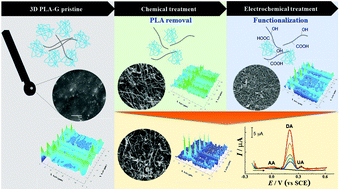Our official English website, www.x-mol.net, welcomes your
feedback! (Note: you will need to create a separate account there.)
Comparison of activation processes for 3D printed PLA-graphene electrodes: electrochemical properties and application for sensing of dopamine.
Analyst ( IF 3.6 ) Pub Date : 2019-12-20 , DOI: 10.1039/c9an01926j Cristiane Kalinke 1 , Naile Vacilotto Neumsteir , Gabriel de Oliveira Aparecido , Thiago Vasconcelos de Barros Ferraz , Pãmyla Layene Dos Santos , Bruno Campos Janegitz , Juliano Alves Bonacin
Analyst ( IF 3.6 ) Pub Date : 2019-12-20 , DOI: 10.1039/c9an01926j Cristiane Kalinke 1 , Naile Vacilotto Neumsteir , Gabriel de Oliveira Aparecido , Thiago Vasconcelos de Barros Ferraz , Pãmyla Layene Dos Santos , Bruno Campos Janegitz , Juliano Alves Bonacin
Affiliation

|
This paper reports the comparison of the electrochemical properties of 3D PLA-graphene electrodes (PLA-G) under different activation conditions and through different processes. In this work, the performance of the electrodes was evaluated after polishing, electrochemical and chemical treatments and a combination of them. The best results were obtained with hydroxide activation using 1.0 mol L-1 NaOH for 30 min of immersion, which promoted the saponification of PLA exposing the graphene nanoribbon structures. The improvement was more evident also after electrochemical activation, which led to a great increase in surface area, defects, electron transfer rate and amount of edge sites. The analytical performance of the proposed PLA-GNaOH-30-EC electrode was evaluated in the presence of dopamine (DA) by three electrochemical techniques, presenting a broad linear range, and limits of detection of 3.49, 2.17 and 1.67 μmol L-1 were obtained by cyclic voltammetry (CV), differential pulse voltammetry (DPV) and square wave voltammetry (SWV), respectively. The separation and quantification of DA in the presence of AA and UA was also reported. The sensor showed good repeatability and reproducibility and was successfully applied to DA determination in synthetic urine and human serum, showing good recovery, from 88.8 to 98.4%. Therefore, the activation methods were essential for the improvement in the 3D PLA-G electrode properties, allowing graphene surface alteration and electrochemical enhancement in the sensing of molecular targets.
中文翻译:

3D打印PLA-石墨烯电极激活过程的比较:电化学性质和多巴胺感测的应用。
本文报告了3D PLA石墨烯电极(PLA-G)在不同激活条件下和通过不同过程的电化学性能的比较。在这项工作中,在抛光,电化学和化学处理以及它们的组合之后评估了电极的性能。用1.0 mol L-1 NaOH浸泡30分钟可激活氢氧化物,从而获得最佳结果,这可促进PLA的皂化作用,从而暴露出石墨烯纳米带结构。电化学活化后的改善也更加明显,这导致表面积,缺陷,电子转移速率和边缘位点数量的大量增加。在存在多巴胺(DA)的情况下,通过三种电化学技术评估了拟议中的PLA-GNaOH-30-EC电极的分析性能,线性范围宽,分别通过循环伏安法(CV),微分脉冲伏安法(DPV)和方波伏安法(SWV)获得3.49、2.17和1.67μmolL-1的检出限。还报道了在AA和UA存在下DA的分离和定量。该传感器具有良好的可重复性和可重复性,已成功用于合成尿液和人血清中DA的测定,回收率良好,从88.8%增至98.4%。因此,活化方法对于改善3D PLA-G电极性能,允许石墨烯表面改变和分子靶标传感的电化学增强至关重要。差分脉冲伏安法(DPV)和方波伏安法(SWV)。还报道了在AA和UA存在下DA的分离和定量。该传感器具有良好的可重复性和可重复性,已成功用于合成尿液和人血清中DA的测定,回收率良好,从88.8%增至98.4%。因此,活化方法对于改善3D PLA-G电极性能,允许石墨烯表面改变和分子靶标传感的电化学增强至关重要。差分脉冲伏安法(DPV)和方波伏安法(SWV)。还报道了在AA和UA存在下DA的分离和定量。该传感器具有良好的可重复性和可重复性,已成功用于合成尿液和人血清中DA的测定,回收率良好,从88.8%增至98.4%。因此,活化方法对于改善3D PLA-G电极性能,允许石墨烯表面改变和分子靶标传感的电化学增强至关重要。显示出良好的恢复,从88.8%降至98.4%。因此,活化方法对于改善3D PLA-G电极性能,允许石墨烯表面改变和分子靶标传感的电化学增强至关重要。显示出良好的恢复,从88.8%降至98.4%。因此,活化方法对于改善3D PLA-G电极性能,允许石墨烯表面改变和分子靶标传感的电化学增强至关重要。
更新日期:2020-02-17
中文翻译:

3D打印PLA-石墨烯电极激活过程的比较:电化学性质和多巴胺感测的应用。
本文报告了3D PLA石墨烯电极(PLA-G)在不同激活条件下和通过不同过程的电化学性能的比较。在这项工作中,在抛光,电化学和化学处理以及它们的组合之后评估了电极的性能。用1.0 mol L-1 NaOH浸泡30分钟可激活氢氧化物,从而获得最佳结果,这可促进PLA的皂化作用,从而暴露出石墨烯纳米带结构。电化学活化后的改善也更加明显,这导致表面积,缺陷,电子转移速率和边缘位点数量的大量增加。在存在多巴胺(DA)的情况下,通过三种电化学技术评估了拟议中的PLA-GNaOH-30-EC电极的分析性能,线性范围宽,分别通过循环伏安法(CV),微分脉冲伏安法(DPV)和方波伏安法(SWV)获得3.49、2.17和1.67μmolL-1的检出限。还报道了在AA和UA存在下DA的分离和定量。该传感器具有良好的可重复性和可重复性,已成功用于合成尿液和人血清中DA的测定,回收率良好,从88.8%增至98.4%。因此,活化方法对于改善3D PLA-G电极性能,允许石墨烯表面改变和分子靶标传感的电化学增强至关重要。差分脉冲伏安法(DPV)和方波伏安法(SWV)。还报道了在AA和UA存在下DA的分离和定量。该传感器具有良好的可重复性和可重复性,已成功用于合成尿液和人血清中DA的测定,回收率良好,从88.8%增至98.4%。因此,活化方法对于改善3D PLA-G电极性能,允许石墨烯表面改变和分子靶标传感的电化学增强至关重要。差分脉冲伏安法(DPV)和方波伏安法(SWV)。还报道了在AA和UA存在下DA的分离和定量。该传感器具有良好的可重复性和可重复性,已成功用于合成尿液和人血清中DA的测定,回收率良好,从88.8%增至98.4%。因此,活化方法对于改善3D PLA-G电极性能,允许石墨烯表面改变和分子靶标传感的电化学增强至关重要。显示出良好的恢复,从88.8%降至98.4%。因此,活化方法对于改善3D PLA-G电极性能,允许石墨烯表面改变和分子靶标传感的电化学增强至关重要。显示出良好的恢复,从88.8%降至98.4%。因此,活化方法对于改善3D PLA-G电极性能,允许石墨烯表面改变和分子靶标传感的电化学增强至关重要。











































 京公网安备 11010802027423号
京公网安备 11010802027423号